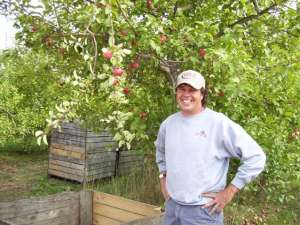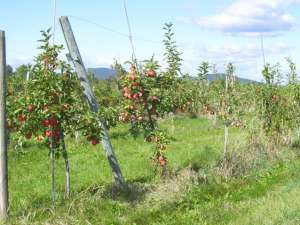|
Case Study of Organic Apple Production:
The following information is drawn from an interview with Harry Ricker of Ricker Hill Orchards in Turner, Maine in March of 2007. We sincerely thank Harry for sharing his knowledge, insight, and experiences in organic apple production. An existing orchard was removed in 1983 and hay, meadow, corn and vegetables were grown on the land until May and June 1999 when new trees were planted. “I knew it was an exceptionally good orchard site that is why we did it there” although in general there is little difference between soil types or environment between organic and other apple orchards. Prior to planting, several soil tests were performed to include the variability of the strip-farmed sections. “The whole thing had had hen manure at some point in the past so the pH was high, as in 7, which is high for Maine. We really didn’t need a lot of fertilizer because we had all kinds of micronutrients.” Land was prepared with plowing, disking, and much rock removal but no grading. “Pre-plant preparations were consistent between organic and nonorganic. I was happy with the way it worked”
Existing blocks within the network of orchards are being transitioned to organic production, beginning around the year 1996, with new blocks transitioned every year. Most of the trees in these blocks are approximately 20 year old Paula Red, Golden Delicious, Cortland, and McIntosh on semi-dwarf rootstock. Organically accepted supplies and materials can be found, for the most part, from regular suppliers. “Sometimes we have to go further away to find the organic ones.” Equipment required for organic production is not a disadvantage. “It is not disabilities with the equipment so much as the inability with the chemicals. You have to use more equipment and you have to use the equipment much more often because the chemicals are not efficacious.” Nutrient management has changed over the years with “many expensive mistakes” made along the way. “Be really careful about the OMRI rules on how to use the chemicals and which ones, as it varies from year to year.” Weed removal did prove difficult during land preparation and is an ongoing battle. “I haven’t had luck with burning or with vinegar. We haven’t tried the $80 an acre stuff because it is a little expensive. I am only doing what I seem to make work” Scouting to determine arthropod management is performed more often in organic orchard blocks than in other orchard blocks. Biological control agents exist in the orchards but “not always in populations that I would prefer.” Large amounts of time are required to manage apple scab disease in the organic orchards through repeated applications of management materials. Deer fence is in place around all blocks and mowing after harvest is used to keep the mouse population down.
Finding information about organic production has been problematic. “We have made it work. We just made a lot of expensive mistakes along the way.” “The OMRI list seems to change yearly, which is kind of a pain, but if you get time to read you can figure it out. It is pretty straightforward.” “You need an Extension economist to sit down with anybody who is contemplating switching to organic to see if it makes sense. Do an economic analysis with real life experience to see how much market is really there, to see if they could grow. I have extra organic apples available that [other growers] can sell to their premium markets for several years until they figure out if it is profitable or not. It is really difficult to grow the right number of apples to meet your market because you get much larger fluctuations in the organic production and less variation in the market, which always seems small.” Organic apple production has been pursued with varied success at Ricker Hill Orchards. Declining yields and lack of market at a premium price reduces profitability from fresh organic fruit. Nutrient and weed management have been constant strains and the inefficiency of materials and biological controls are not keeping up with disease and insect pressures. The availability of materials and the equipment to apply them, however, are acceptable. Organic regulations are simple to follow yet change often. A significant effort is needed to stay current with these changes. Harry Ricker is not optimistic about the future of organic apple production “because more and more people are [increasing] supply and the market hasn’t been that good. The price will probably come down which will be pretty much the end of it.” This case study interview and narrative conducted by: |


